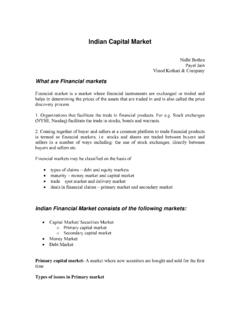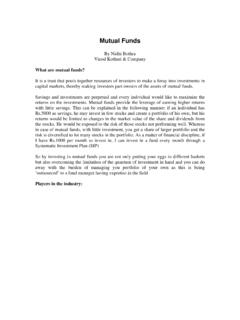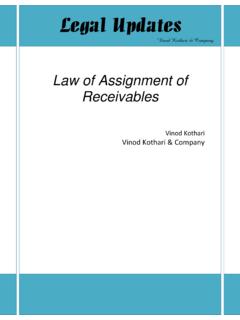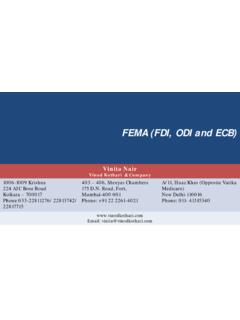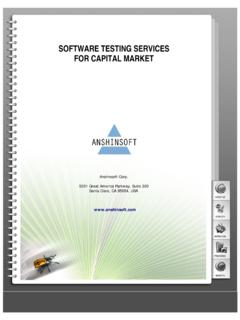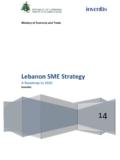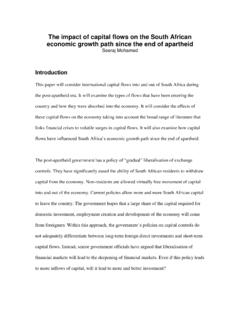Transcription of Indian Capital Market - Vinod Kothari Consultants
1 Indian Capital Market Nidhi Bothra Payel Jain Vinod Kothari & Company What are Financial markets Financial Market is a Market where financial instruments are exchanged or traded and helps in determining the prices of the assets that are traded in and is also called the price discovery process. 1. Organizations that facilitate the trade in financial products. For Stock exchanges (NYSE, Nasdaq) facilitate the trade in stocks, bonds and warrants. 2. Coming together of buyer and sellers at a common platform to trade financial products is termed as financial markets, stocks and shares are traded between buyers and sellers in a number of ways including: the use of stock exchanges; directly between buyers and sellers etc.
2 Financial markets may be classified on the basis of types of claims debt and equity markets maturity money Market and Capital Market trade spot Market and delivery Market deals in financial claims primary Market and secondary Market Indian Financial Market consists of the following markets: Capital Market / Securities Market o Primary Capital Market o Secondary Capital Market Money Market Debt Market Primary Capital Market - A Market where new securities are bought and sold for the first time Types of issues in Primary Market Initial public offer (IPO) (in case of an unlisted company), Follow-on public offer (FPO), Rights offer such that securities are offered to existing shareholders, Preferential issue/ bonus issue/ QIB placement Composite issue, that is, mixture of a rights and public offer, or offer for sale (offer of securities by existing shareholders to the public for subscription).
3 Difference between Primary Market Secondary Market Deals with new securities Market for existing securities, which are already listed Provides additional Capital to issuer No additional Capital generated. Provides companies liquidity to existing stock Leading stock exchanges: Bombay Stock Exchange Limited o Oldest in Asia o Presence in 417 cities and towns in India o Trading in equity, debt instrument and derivatives National Stock Exchange New York Stock Exchange NYSE). NASDAQ. London Stock Exchange Functions of Stock Exchanges Liquidity and marketability of securities Fair price determination Source of long-tern funds Helps in Capital formation Reflects general state of economy Basics of Stock Market Indices: A stock Market index is the reflection of the Market as a whole.
4 It is a representative of the entire stock Market . Movements in the index represent the average returns obtained by the investors. Stock Market index is sensitive to the news of: Company specific Country specific Thus the movement in the stock index is also the reflection of the expectation of the future performance of the companies listed on the exchange Index Calculation: Step 1: Calculate the weightage of each scrip Weightage = (Mcapit / total Market cap)*100. Step 2: Value of index n {Mcapit * Weightit}/ Wb I=1. Where;. Mcapit = Market cap of scrip i at time t . = price of the share * number of outstanding shares Wb = Sum of all the Market cap of all the scrips in the index during the base year Settlement cycles: Settlement is the process whereby the trader who has made purchases of scrip makes payment and the seller selling the scrip delivers the securities.
5 This settlement process is carried out by Clearing Houses for the stock exchanges. The Clearing House acts like an intermediary in every transaction and acts as a seller to all buyers and buyer to all sellers. Capital Market and money Market : Financial markets can broadly be divided into money and Capital Market . Money Market : Money Market is a Market for debt securities that pay off in the short term usually less than one year, for example the Market for 90-days treasury bills. This Market encompasses the trading and issuance of short term non equity debt instruments including treasury bills, commercial papers, bankers acceptance, certificates of deposits, etc. Capital Market : Capital Market is a Market for long-term debt and equity shares.
6 In this Market , the Capital funds comprising of both equity and debt are issued and traded. This also includes private placement sources of debt and equity as well as organized markets like stock exchanges. Capital Market includes financial instruments with more than one year maturity Significance of Capital Markets A well functioning stock Market may help the development process in an economy through the following channels: 1. growth of savings, 2. Efficient allocation of investment resources, 3. Better utilization of the existing resources. In Market economy like India, financial Market institutions provide the avenue by which long-term savings are mobilized and channelled into investments. Confidence of the investors in the Market is imperative for the growth and development of the Market .
7 For any stock Market , the Market Indices is the barometer of its performance and reflects the prevailing sentiments of the entire economy. Stock index is created to provide investors with the information regarding the average share price in the stock Market . The ups and downs in the index represent the movement of the equity Market . These indices need to represent the return obtained by typical portfolios in the country. Generally, the stock price of any company is vulnerable to three types of news: Company specific Industry specific Economy specific An all share index includes stocks from all the sectors of the economy and thus cancels out the stock and sector specific news and events that affect stock prices, (law of portfolio diversification) and reflect the overall performance of the company/equity Market and the news affecting it.
8 The most important use of an equity Market index is as a benchmark for a portfolio of stocks. All diversified portfolios, belonging either to retail investors or mutual funds, use the common stock index as a yardstick for their returns. Indices are useful in modern financial application of derivatives. Capital Market Instruments some of the Capital Market instruments are: Equity Preference shares Debenture/ Bonds ADRs/ GDRs Derivatives Corporate securities Shares The total Capital of a company may be divided into small units called shares. For example, if the required Capital of a company is US $5,00,000 and is divided into 50,000. units of US $10 each, each unit is called a share of face value US $10.
9 A share may be of any face value depending upon the Capital required and the number of shares into which it is divided. The holders of the shares are called share holders. The shares can be purchased or sold only in integral multiples. Equity shares signify ownership in a corporation and represent claim over the financial assets and earnings of the corporation. Shareholders enjoy voting rights and the right to receive dividends; however in case of liquidation they will receive residuals, after all the creditors of the company are settled in full. A company may invite investors to subscribe for the shares by the way of: Public issue through prospectus Tender/ book building process Offer for sale Placement method Rights issue Stocks The word stock refers to the old English law tradition where a share in the Capital of the company was not divided into shares of fixed denomination but was issued as one chunk.
10 This concept is no more prevalent, but the word stock continues. The word joint stock companies also refers to this tradition. Debt Instruments A contractual arrangement in which the issuer agrees to pay interest and repay the borrowed amount after a specified period of time is a debt instrument. Certain features common to all debt instruments are: Maturity the number of years over which the issuer agrees to meet the contractual obligations is the term to maturity. Debt instruments are classified on the basis of the time remaining to maturity Par value the face value or principal value of the debt instrument is called the par value. Coupon rate agreed rate of interest that is paid periodically to the investor and is calculated as a percentage of the face value.
